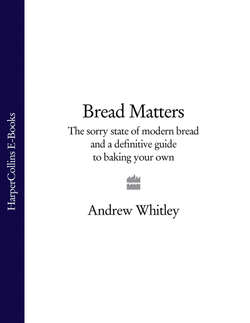Читать книгу Bread Matters: The sorry state of modern bread and a definitive guide to baking your own - Andrew Whitley - Страница 8
Gut feelings
ОглавлениеWhy would hundreds of thousands of people stop eating bread and eliminate wheat from their diet? Cynics would say that the emergence of private allergy clinics and self-diagnosis by mail order might have something to do with it. For its part, much of the medical profession remains sniffy about the connection between diet and wellbeing. Yet scientific studies do show a surprisingly widespread sensitivity to wheat. This can take an extreme form known as coeliac disease, which is a serious reaction to gliadin, one of the gluten-forming proteins present mostly in wheat but also in smaller amounts in rye, barley and oats. Coeliac disease has a genetic component and, according to the Coeliac Society, may affect as many as one in 100 people in the UK. In his book The Complete Guide to Food Allergy and Intolerance (Bloomsbury, 1998, with L. Gamlin), leading allergy expert Professor Jonathan Brostoff describes coeliacs as ‘casualties of the slow adaptation process between the human race and wheat.’
It seems that sensitivity to gluten and wheat is like an iceberg. The visible part is composed of coeliacs whose condition is diagnosed by well-established tests and whose only treatment is a complete avoidance of gluten. Below the surface is a much larger group of people who have a sensitivity to wheat with varying degrees of severity, from mild discomfort when consuming bread to a condition known as ‘wheat-dependent exercise-induced anaphylaxis’1.
The strange thing is how recent all this is. Coeliac disease was first diagnosed in the 1950s, but widespread wheat intolerance emerged less than 20 years ago. At almost the same time, people started talking about an invasive strain of yeast called Candida albicans, which caused joint pain and digestive discomfort.
For a baker, this came as quite a shock. For 13 years or so I had been selling a range of wheat breads raised with yeast without once hearing about wheat or yeast intolerance or allergy. Suddenly people started ringing up asking for breads made without wheat or baker’s yeast – on the face of it, something of a tall order, given that the remaining ingredients of bread are just salt and water. Luckily, I was just developing a sourdough rye bread that contained no wheat and was raised using a spontaneous fermentation (lasting about 24 hours) of ‘wild’ yeasts present in the flour. Customers tried it and found that their digestive problems were eased. That was the first in a long line of products made without wheat for a market that had appeared from nowhere. Call it anecdotal (the word opponents use when your argument rattles them), but the evidence was clear: more and more people were buying products specifically because they didn’t contain wheat, or industrial yeast, or both. The bread on offer in the shops seemed to be making them ill.
